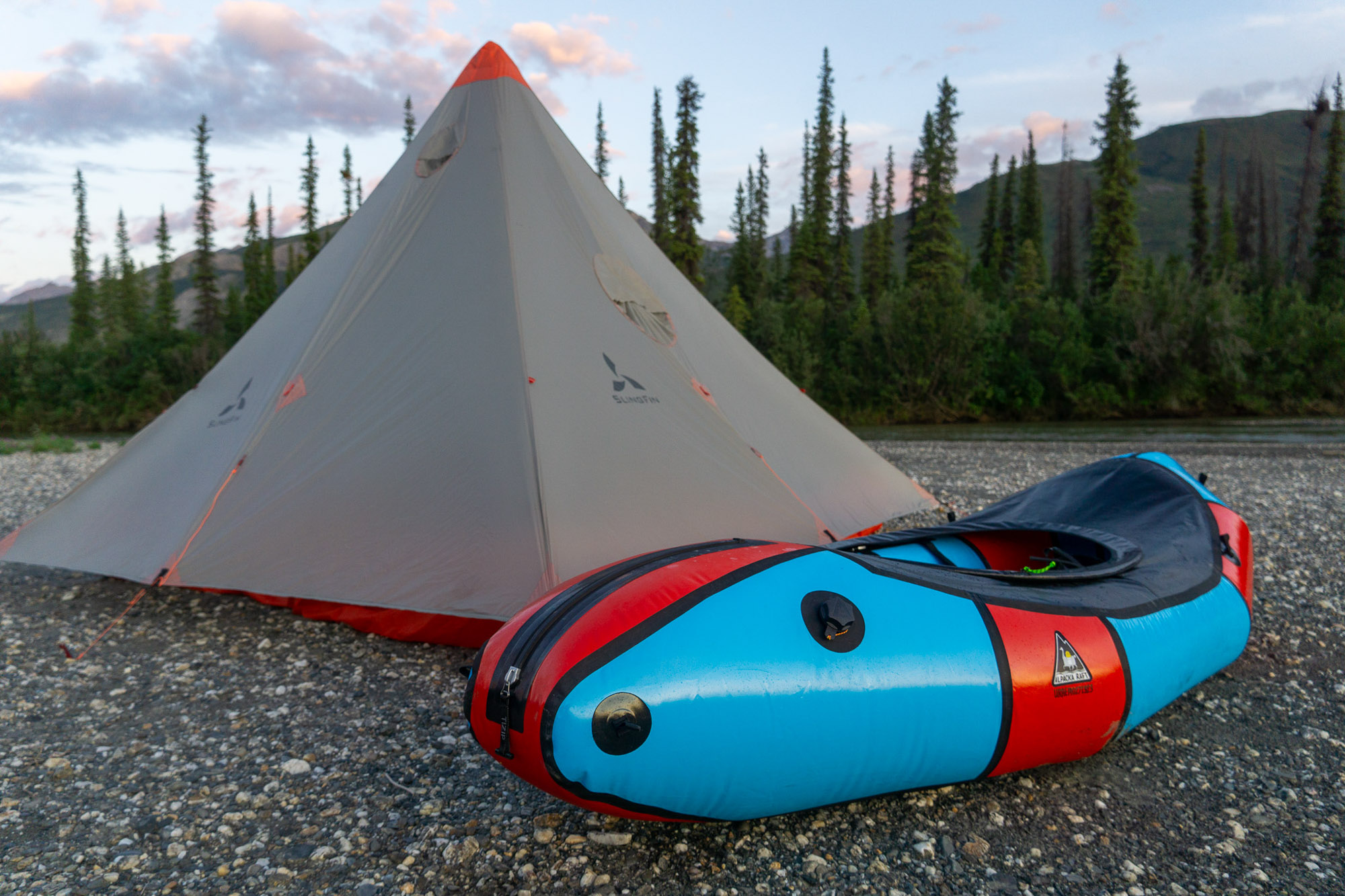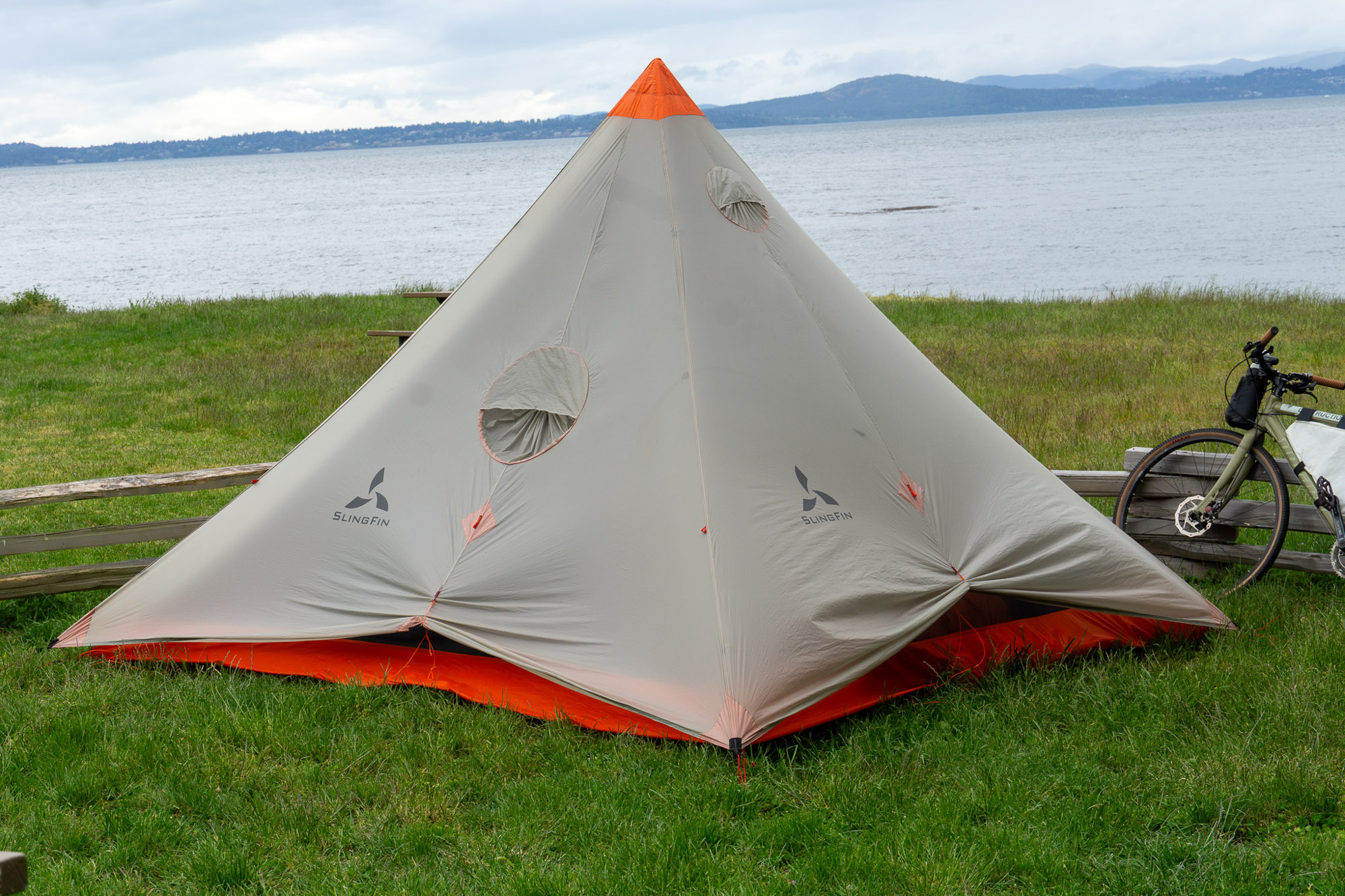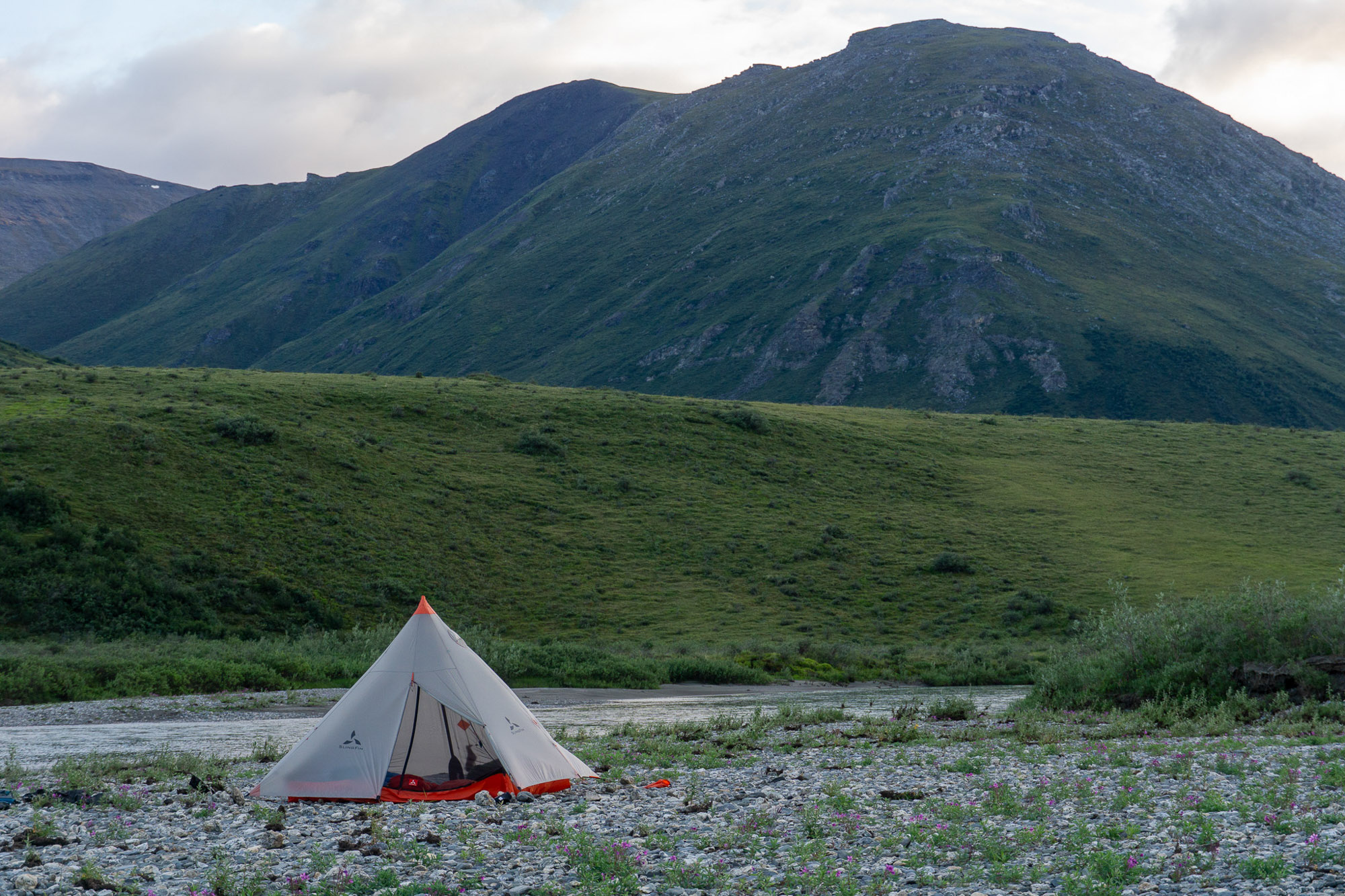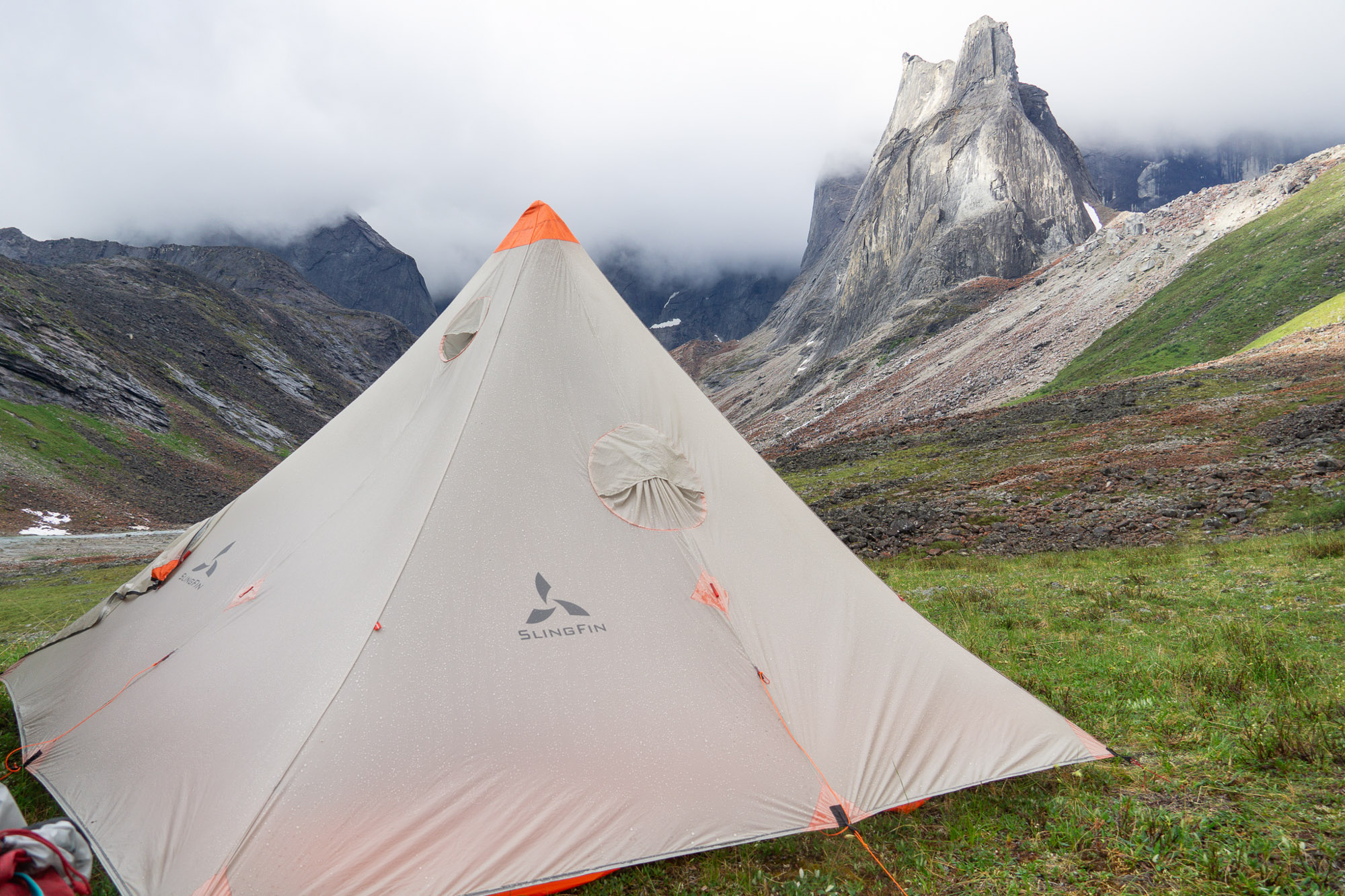Some years ago, in a pandemic-fueled frenzy, I dragged out my pyramid tarp shelter for some surgery. I wasn’t happy with a few aspects, but the main ask was for adjustable tensioners at the corners and mid-panel tie-outs for stiff winds. I’m no seamster, but the final product wasn’t half bad — at the expense of my sanity.
I now know that I should have saved my fingertips (and brain) the pain of fighting the sewing machine: When the new SlingFin Cinder Cone Pyramid Tent arrived, it was everything I had made my old tarp into and much more.
I’ve now used the Cinder Cone as a basecamp shelter in Patagonia, a bikepacking refuge on a few island trips, and a deep backcountry haven above the Arctic Circle on a packrafting circuit. In all three locations, the versatility of this pyramid tarp impressed me.
In short: The SlingFin Cinder Cone may be the best pyramid shelter I’ve used of this style yet. It is generously sized, ventilates exceptionally well, and is hardened against the style of storms that brew over the Kahiltna glacier basecamp or Southern Patagonian icefield. It’s not a quiver-killer, but it does do a lot of things quite well.
Looking for a new shelter to weather all storms? Check out how the Cinder Cone compares to other tents in GearJunkie’s Best 4-Season Tents Buyer’s Guide.
-
Super-versatile setup options -
Many ventilation ports and systems -
Rugged nylon 66 and ALUULA Durlyte construction -
Small packed size
-
Will need to be seam sealed -
No hang loop on the exterior of the tarp
SlingFin Cinder Cone Pyramid Tent: Review

Pyramid tarp shelters are some of the most versatile backcountry options out there. You can run these shelters with or without an inner floor, elevate them to clear awkward humps in tight sites, and pitch them four different ways into the wind. SlingFin seems to have brewed up the Cinder Cone after serious meditation on what the ideal ‘mid would look like.
The brand has made a name for itself in the world of four-season mountaineering-styled shelters, but also has bled over into lightweight shelters that thru-hikers, bikepackers, and paddlers have taken up and relied on as a tougher-than-normal option. The Cinder Cone is certainly in this camp.
I aimed to test this shelter on its versatility, and hit it with the spread of harsh weather you might foreseeably take it out in. From 50 mph wind and midsummer snowstorms in Patagonia to soaked tundra camping in Alaska, it didn’t wilt all year.
I also tested the optional Mesh Body for the Cinder Cone ($260), which was a nice addition and the same packed size as the tarp itself. I’d likely leave it behind on summer mountaineering trips in the Pacific Northwest, but the bug protection it provided ranged from handy to necessary on the trips I used it on.
A Burly Build


SlingFin doesn’t half-bake any of its designs, and the Cinder Cone only drives that point home. They also are huge textile nerds, it appears.
The 10D sil-nylon 66 used in the tarp’s body is top-notch stuff that keeps the bulk down (a Dyneema Composite Fiber Hyperlite Mountain Gear Ultamid 4 is about double the volume of the Cinder Cone when packed), but it’s the ALUULA textile in the tarp’s top cap that makes it different.
ALUULA’s Durlyte is some bleeding-edge stuff that’s further down the continuum from Dyneema Composite Fabric and Challenge Ultra materials on the durability scale (the ultralight industry is in an arms race toward light-and-tough, with new woven Dyneema textiles debuting earlier this summer).
Its use in the top cap of the tarp is a perfect application, as it’s the single point of contact for the tarp’s structure, and making it robust allows you to use unconventional means, such as a kayak paddle.
Otherwise, all of the trim I added to my old pyramid tarp is present on the Cinder Cone. The brand tacks seven guyline loops onto it, plus Linelocs on all of the perimeter pull-out loops. There’s also a two-way YKK VISLON Aquaguard zipper for the entry (plus two preinstalled sliders for spares) and something called Radial Seam Tape, which is a hem of webbing along the bottom edge that limits stretch.
Across all my uses, the Cinder Cone showed up when I needed it with the reinforcements in the places I’d expect wear to accumulate.
Set Up for Any Situation


The Cinder Cone’s ability to set up in rugged or unfavorable terrain is a huge boon, and after an 18-hour day in Alaska — crossing two soaked mountain passes — it was easy to throw down the tarp on some sorta-level tundra and make it work.
SlingFin doesn’t include the pole you’ll need to set up the tarp, and there’s a good reason — you’ve probably already got it. Whether that’s lashing together a few trekking poles, using a packraft paddle, or finding a solid stick, there are plenty of options. For space-limited sports (like bikepacking), SlingFin now sells a carbon collapsible pole as well.
Setting up a pyramid shelter can sometimes create awkward tension lines if you don’t nail the footprint. The Cinder Cone tacks on another little ingenious mod here in a Quick Pitch Cord that connects opposite corners of the tarp. The perfect distance is always maintained, and setup goes smoothly. That’s smart.
When an oddball snowstorm in Patagonia dropped heavy snow this February, the mid-panel guy lines were easy to tack down. In Alaska, I was able to adjust the Linelocs to drop the windward edge of the tarp to the river bar to keep a stiff wind off us.
In fact, the only time the design was really challenged was when a river rose quickly and flooded us out. Even still, since there’s only a single pole, we packed bags (in the dry tarp), pulled stakes, and moved to higher ground. In minutes, we were back under the tarp.
Toss Open the Windows


The ventilation on the Cinder Cone is unreal. Many pyramid shelters turn into ovens when set up on a sun-baked glacier, but this tarp is the exception. The unique trio of portals set high on the walls can be thrown open when temperatures rise or adjusted individually to shuttle breezes in.
In Patagonia, we had to set up the tarp on the exposed shores of a lake just outside of Torres del Paine National Park, where a 50 mph wind was buffeting us relentlessly. Opening the through-vents here made for just enough pressure relief to get the tarp up, and while it was a wildly noisy night, the Cinder Cone stood strong while the winds died down.
The ventilation options don’t stop there, either. A simple cord system can lift the tarp’s hems to sneak breezes under it, and there’s one on every wall but the door.
The Cinder Cone breathes much better compared to the Black Diamond Mega Snow 4P Mid — frequently used as a cook tent on routes like the West Buttress of Denali. As a single-wall shelter, you’ll always need to manage moisture in this tarp, but the ventilation options make it simple and effective.
Room for Improvement
While the Cinder Cone answered nearly all my pyramid shelter wishes, I can always find something to grumble about. The second night in Alaska was a wet one, with the rain really beginning to drive around 1 a.m., followed by some drips coming in from the peak of the tarp.
It appeared that only seams under tension weeped, so once I returned from the trip, I hit these areas with some Gear Aid Tent Seam Sealant. The patch job was deemed successful after curing and testing it with the hose. It’s not a tough process, and anyone running the Cinder Cone should do the same.
The materials used on the Cinder Cone and the mesh inner are also not indestructible. On the last night of the trip, I tore the floor of the shelter while moving the kayak paddle around. It’s nothing a little Tenacious Tape can’t fix, but it’s also important to keep in mind.
Finally, a single-line-item wish list: After we had flown out of the backcountry in Alaska, we stayed in a bush plane hangar for the night and used the mesh inner to keep the mosquitoes at bay. With no way to set up a pole inside and stake it out and no hang loop on the peak, we had to get creative to get it set up. A simple hang loop would be greatly appreciated and an easy addition. I may just break out the sewing machine myself.
SlingFin Cinder Cone Pyramid Tent: Conclusion


The pyramid tarp space is a surprisingly vibrant corner of the backcountry shelter market, with serious competition like the Hyperlite Mountain Gear Ultamid 4, Black Diamond Mega Snow, and cottage industry options like the Mountain Laurel Designs Supermid. However, I think that the SlingFin Cinder Cone bests them all.
It’s cheaper and packs down twice as small as the Ultamid, has much better ventilation and features than the Mega Snow, and is more widely available than the Supermid. At $435 (without the inner), it’s nearly half the price of the Ultamid, which highlights the impressive shelter you can get out of some high-quality materials (that aren’t exclusively the lightest).
This winter, I’m looking forward to using the Cinder Cone as a ski overnight and traverse shelter here in the North Cascades. It’s the perfect blend of compact when packed and roomy when deployed, and digging down into the snow should yield a wild amount of space. I’m not saying it’s a quiver killer, but it has replaced my old doctored-up mid outright. No sewing required.
Read the full article here




